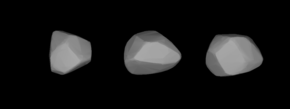 A three-dimensional model of 222 Lucia based on its light curve. | |
| Discovery | |
|---|---|
| Discovered by | Johann Palisa |
| Discovery date | 9 February 1882 |
| Designations | |
| (222) Lucia | |
| Pronunciation |
/ˈluːʃiə/
[1] German: [ˈluːtsiɐ] |
| A882 CA, 1899 EC 1919 AB | |
| Main belt ( Themis) | |
| Orbital characteristics [2] | |
| Epoch 31 July 2016 ( JD 2457600.5) | |
| Uncertainty parameter 0 | |
| Observation arc | 117.10 yr (42769 d) |
| Aphelion | 3.5529 AU (531.51 Gm) |
| Perihelion | 2.7296 AU (408.34 Gm) |
| 3.1412 AU (469.92 Gm) | |
| Eccentricity | 0.13105 |
| 5.57 yr (2033.5 d) | |
Average
orbital speed | 16.82 km/s |
| 349.267 ° | |
| 0° 10m 37.308s / day | |
| Inclination | 2.1494° |
| 80.141° | |
| 180.953° | |
| Physical characteristics | |
| Dimensions | 54.66±3.9 km |
| 7.80 h (0.325 d) | |
| 0.1318±0.021 | |
| C? | |
| 9.13 | |
Lucia ( minor planet designation: 222 Lucia) is a large Themistian asteroid. It was discovered by Johann Palisa on 9 February 1882 in Vienna and named after Lucia, daughter of Austro-Hungarian explorer Graf Wilczek.
This object is spectral C-type and is probably composed of primitive carbonaceous material. Based upon analysis of infrared spectra, it has a diameter of 59.8 ± 0.8 km. This object belongs to the Themis family, which was formed by the break-up of a larger parent body about a billion years ago. [3]
References
- ^ Noah Webster (1884) A Practical Dictionary of the English Language
- ^ "222 Lucia". JPL Small-Body Database. NASA/ Jet Propulsion Laboratory. Retrieved 12 May 2016.
- ^ Lagoa, V. Alí; et al., "5-14 μm Spitzer spectra of Themis family asteroids", Astronomy & Astrophysics, 537: A73, Bibcode: 2012A&A...537A..73L, doi: 10.1051/0004-6361/201118142.
External links
- Lightcurve plot of 222 Lucia, Palmer Divide Observatory, B. D. Warner (1999)
- Asteroid Lightcurve Database (LCDB), query form ( info Archived 16 December 2017 at the Wayback Machine)
- Dictionary of Minor Planet Names, Google books
- Asteroids and comets rotation curves, CdR – Observatoire de Genève, Raoul Behrend
- Discovery Circumstances: Numbered Minor Planets (1)-(5000) – Minor Planet Center
- 222 Lucia at AstDyS-2, Asteroids—Dynamic Site
- 222 Lucia at the JPL Small-Body Database
 A three-dimensional model of 222 Lucia based on its light curve. | |
| Discovery | |
|---|---|
| Discovered by | Johann Palisa |
| Discovery date | 9 February 1882 |
| Designations | |
| (222) Lucia | |
| Pronunciation |
/ˈluːʃiə/
[1] German: [ˈluːtsiɐ] |
| A882 CA, 1899 EC 1919 AB | |
| Main belt ( Themis) | |
| Orbital characteristics [2] | |
| Epoch 31 July 2016 ( JD 2457600.5) | |
| Uncertainty parameter 0 | |
| Observation arc | 117.10 yr (42769 d) |
| Aphelion | 3.5529 AU (531.51 Gm) |
| Perihelion | 2.7296 AU (408.34 Gm) |
| 3.1412 AU (469.92 Gm) | |
| Eccentricity | 0.13105 |
| 5.57 yr (2033.5 d) | |
Average
orbital speed | 16.82 km/s |
| 349.267 ° | |
| 0° 10m 37.308s / day | |
| Inclination | 2.1494° |
| 80.141° | |
| 180.953° | |
| Physical characteristics | |
| Dimensions | 54.66±3.9 km |
| 7.80 h (0.325 d) | |
| 0.1318±0.021 | |
| C? | |
| 9.13 | |
Lucia ( minor planet designation: 222 Lucia) is a large Themistian asteroid. It was discovered by Johann Palisa on 9 February 1882 in Vienna and named after Lucia, daughter of Austro-Hungarian explorer Graf Wilczek.
This object is spectral C-type and is probably composed of primitive carbonaceous material. Based upon analysis of infrared spectra, it has a diameter of 59.8 ± 0.8 km. This object belongs to the Themis family, which was formed by the break-up of a larger parent body about a billion years ago. [3]
References
- ^ Noah Webster (1884) A Practical Dictionary of the English Language
- ^ "222 Lucia". JPL Small-Body Database. NASA/ Jet Propulsion Laboratory. Retrieved 12 May 2016.
- ^ Lagoa, V. Alí; et al., "5-14 μm Spitzer spectra of Themis family asteroids", Astronomy & Astrophysics, 537: A73, Bibcode: 2012A&A...537A..73L, doi: 10.1051/0004-6361/201118142.
External links
- Lightcurve plot of 222 Lucia, Palmer Divide Observatory, B. D. Warner (1999)
- Asteroid Lightcurve Database (LCDB), query form ( info Archived 16 December 2017 at the Wayback Machine)
- Dictionary of Minor Planet Names, Google books
- Asteroids and comets rotation curves, CdR – Observatoire de Genève, Raoul Behrend
- Discovery Circumstances: Numbered Minor Planets (1)-(5000) – Minor Planet Center
- 222 Lucia at AstDyS-2, Asteroids—Dynamic Site
- 222 Lucia at the JPL Small-Body Database